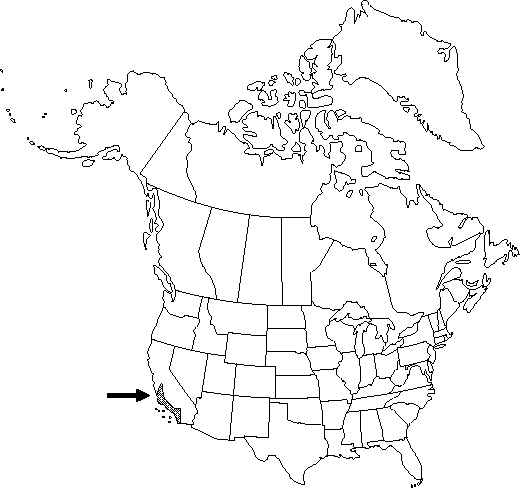Delphinium cardinale
Bot. Mag., plate 4887. 1855.
Stems (33-)50-150(-280) cm; base reddish, ± puberulent. Leaves mostly cauline; basal leaves absent at anthesis except in small plants; cauline leaves 5-18 at anthesis; petiole 1-12 cm. Leaf blade round to reniform, 3-7 × 5-10 cm, nearly glabrous; ultimate lobes 0-27, width 5-40 mm (basal), 0.5-6 mm (cauline). Inflorescences 10-40(-80)-flowered, open, narrowly pyramidal; pedicel spreading, (1-)2-5 cm, ± puberulent; bracteoles (2-)7-15(-25) mm from flowers, green, linear, 3-7 mm, glabrous to puberulent. Flowers: sepals red, glabrous, lateral sepals forward pointing, 11-15 × 5-8 mm, spurs straight, stout, slightly ascending, 15-24 mm; lower petal blades nearly coplanar with claw, exposing stamens, 2-5 mm, clefts 0.5-1.5 mm; hairs centered at base of cleft, short, sparse, yellow. Fruits erect, 9-18 mm, 2.5-4 times longer than wide, glabrous. Seeds unwinged; seed coat cells with margins undulate, surfaces roughened. 2n = 16.
Phenology: Flowering spring–early summer.
Habitat: Slopes (often unstable) in chaparral
Elevation: 50-1500 m
Distribution

Calif., Mexico (Baja California, Baja California Sur).
Discussion
Hybrids between Delphinium cardinale and D. parryi have been named D. ×inflexum Davidson. Because of horticultural interest in red-flowered delphiniums, garden hybrids have been made with D. elatum, D. hesperium, D. hutchinsoniae, D. nudicaule, D. parishii, D. penardii, D. scopulorum, D. tatsienense Franchet, D. uliginosum, and D. zalil Aitchison & Hemsley, although D. cardinale does not grow with any of these in the wild.
Plants of Delphinium cardinale are quite variable in size, leaf distribution, and pubescence, resulting in considerable differences between, and sometimes within, populations. No patterns could be seen, however, to justify recognition of separate taxa within D. cardinale. Populations farther south (in Baja California, Mexico) may represent a distinct entity; they require further study.
The only possible confusion between Delphinium cardinale (seeds not ringed, fruits erect, grows in relatively dry sites) and another taxon might occur with Delphinium nudicaule (seeds ringed, fruits spreading, grows in moist habitats). The two are separated geographically and phenologically (although D. cardinale may begin flowering in southern California before D. nudicaule has finished in northern California).
Selected References
None.